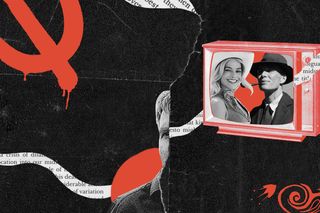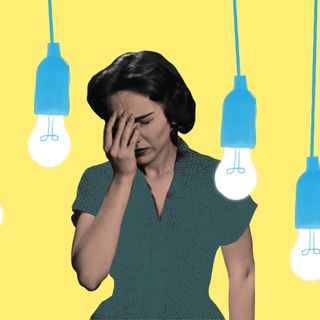
‘Barbenheimer’ Was a Failure of Imagination
Barbenheimer looks back into the past; Mark Fisher’s ‘Acid Communism’ shows how to dream about the future.

In ‘Manifesto This,’ we dialogue with a radical text to dream of a better world.
Barbenheimer is a phenomenon that looks into the past to search for meaning we can make of our present worlds. But Mark Fisher’s ‘Acid Communism’ shows why it’s futile to look back without dreaming about the future.
I. “Acid Communism is the name I have given to this spectre. The concept of acid communism is a provocation and a promise. It is a joke of sorts, but one with very serious purpose. It points to something that, at one point, seemed inevitable, but which now appears impossible: the convergence of class consciousness, socialist-feminist consciousness-raising and psychedelic consciousness, the fusion of new social movements with a communist project, an unprecedented aestheticisation of everyday life.”
Mark Fisher, the theorist who died by suicide and left an incomplete manuscript to what might have been his defining thesis about the world, dreamt of the “spectre of a world that could be free.” Art was one of the last frontiers left for imagining what this could be; politics and the revolution would follow.
Barbie and Oppenheimer have almost nothing in common, except for one thing: inevitability.
In Barbie, the inevitability is real life. In Oppenheimer, the inevitability is nuclear destruction. How do we imagine a world that gets better if we’re unable to picture what that looks like?
And more importantly, neither film asks questions about the past that could allow even a glimpse of a better future. Why was the bomb the only way? We know the story of the atomic bomb’s father now. We know less — if anything at all — about why the bomb felt necessary after the enemy’s defeat. In seeing the world through Oppenheimer’s eyes, we’re seeing the present, apocalyptic world as an inevitability. The horror isn’t the atomic bomb that incinerated close to 200,000 Japanese people. The horror is that it was inevitable. The future in Oppenheimer is a future that was always meant to happen. And so was the near-zero possibility of a total nuclear apocalypse. What were the possibilities of peace without a bomb? When the present is predetermined and the future unthinkable, it’s impossible for art to ask questions about the alternative.
Barbie, on the other hand, does the opposite: it asks questions about what another, better world could look like but works backwards from there to arrive at a bleak conclusion: a better world is improbable, because real life exists. Real life — with its violent misogyny and its masculine order gridlocked in a death drive — is inevitable. Womanhood would have to find itself within it. The existential melancholy of Barbie isn’t that she left the utopian Dreamhouse — it’s that the Dreamhouse was bereft of dreams that could actually imagine anything beyond symbolic professional success for Barbies, whose real profession is to be perfect.
II. “Neoliberalism’s victory, of course, depended upon a cooption of the concept of freedom. Neoliberal freedom, evidently, is not a freedom from work, but freedom through work.”
We’ve seen stories become products. Barbie is a product-turned-story. Accordingly, President Barbie, Doctor Barbie, Astronaut Barbie are all raceless, classless, and if we were to imagine it closer to home (and the film demands that we must all see ourselves in it), casteless stories. The presence of patriarchy, and the absence of other power structures within Barbie’s imagination only points to one thing: the dominant identity. Barbie is universal in its feminism, which is to say, its utopia and its critique are from the perspective of Whiteness. In such a world, a Black woman President Barbie is a side character who is brainwashed by patriarchy; stereotypical Barbie is not. The critique ends at self-awareness of privilege — but it blends into the inevitability that the original Barbie, who is thin, blonde, and White, will always be the point of view and the point of reference.
In short: if Barbie’s job is to be perfect, who does her dishes and her laundry and her housekeeping? Can freedom exist without anyone to do the work, and can workers who aren’t presidents and doctors ever be free?
III. “Mass culture — and music culture in particular — was a terrain of struggle rather than a dominion of capital. The relationship between aesthetic forms and politics was unstable and inchoate — aesthetic forms did not simply ‘express’ some already-existing capitalist reality, they anticipated and actually produced new possibilities.”
Oppenheimer isn’t a linear story, just like history isn’t a linear narrative. So why do so many reviews continue toe the party line and reiterate the inevitability of the bomb to end the war? If the film didn’t make us question the inevitability of wiping out two cities, what was it for?
Oppenheimer’s point of view is that of a lapsed communist and a patriot. This is what we see; the text contains nothing outside of it. But Oppenheimer is a celebration of storytelling more than the story itself. Confined to the point of view a brilliant, tortured genius, we’re allowed to imagine little else. By default, there’s no room for questions outside the purview of this point of view. It’s a known story, retold in the known fashion, existing in a known universe where nuclear patriotism is inevitable. We can only feel disgust and horror about it.
Oppenheimer’s own disgust and horror with the consequences of his work was what made his story worth telling. In the moral universe of Oppenheimer, acknowledging the horror cleanses — or at least, begins to cleanse — the unfathomable magnitudes of blood from one’s hands. Discomfort, it seems to say, makes a morally complex man out of someone who built the most awesome, terrible force of destruction the world has seen. If anything, Oppenheimer is an exercise in moral salvation for a man without whom the world may not have had nuclear weapons. Ultimately, the myopic individualism of the film is a triumph of neoliberalism.
IV. “The first obstructive figure of the left was the complacent steward of Cold War organised labour or social democracy: backward-looking, bureaucratic, resigned to the ‘inevitability‘ of capitalism.”
The most damning fact of Barbie’s utopia is that Barbieland — where women have agency and joy, and aren’t defined in relation to the gaze of men — is only possible because a corporation manufactures it. Barbie offers itself to us as a radically new way of thinking about girlhood and femininity, because a corporation wanted it to happen. Irony is profitable; capitalism becoming self-aware is the deradicalizing sedative slow dripped into us as we applaud. But subversive cinema isn’t possible if the subversion is the selling point.
The most damning fact of Oppenheimer, correspondingly, is that its main villain is just another man who double-crossed a man grappling with nuclear horror. The nuclear fallout was inevitable; the tyranny through government bureaucracy, on the other hand, was the unexpected. If the father of the atom bomb can resign himself to the horrors of what he has wrought, what’s left to challenge? Capitalism seems, if anything, a trifling concern in the face of the Earth’s doom. If there’s a chance the future won’t exist, the only place to look for stories is in the past. And the past drives the inevitability home.
The moment represents the failure of progressive art that’s transgressive. What’s left to hope for if all we can engage with is a one-dimensional past? Why are the heroes — or the complex protagonists — still the ones with the most social, cultural, political currency? It’s less a question of what happens in the movies. It’s more a question of why these were the two movies that turned into a paradigm shift for culture and art.
V. “The crucial defining feature of the psychedelic is the question of consciousness, and its relationship to what is experienced as reality. If the very fundamentals of our experience, such as our sense of space and time, can be altered, does that not mean that the categories by which we live are plastic, mutable?”
The tragedy of Barbie was that in order to get in touch with her humanity, Barbie would have to embrace change, the foremost ingredient of life, and enter the real world as a human being. And the first thing she does — and the last thing we see her do — is see a gynaecologist. Barbie, a doll with “no genitals” as she put it, reinscribes gender when she becomes “human.” She wears a beige blazer instead of unrealistic hot pink. Moved by the beauty of women’s lives despite the world they live in, Barbie willingly enters it as a compliant citizen. Unlike what The Economist said, Barbie isn’t escapism. It’s a reproduction of the categories constraining women in the real world. And it never shows us what else could be possible.
Arguably, the most unforgivable fact about Barbie is that Mattel made it happen. It renders a moment swollen with tenderness and revelation — when Barbie tells an elderly woman she is beautiful — bloodless. For where are the elderly Barbies? Who, in the end, can be Barbie? It’s for Mattel to decide.
And arguably, the most unforgivable fact about Oppenheimer is that it meekly accepts the near-zero — but not quite zero — possibility of world annihilation.
What do we do when the best thing the culture has to offer is a temporary sedative to hopelessness?
VI. “We now know that the revolution did not happen. But the material conditions for such a revolution are more in place in the twenty-first century than they were in 1977. What has shifted beyond all recognition since then is the existential and emotional atmosphere.”
Barbenheimer as a phenomenon is deeply, existentially, pessimistic. It created a cultural paradigm shift that now takes it for granted that optimism is no longer available in art. No matter how much we dress up in pink and in wear fedora hats, we wear the outfits and watch the movies when we’re allowed to do so, when time outside of waged labor permits it. We do so under patriarchy and an ever-precarious nuclear detente. In order to escape the existential dread of the real world, we consume art that forecloses that escape.
And we’ll continue debating true meaning of both films — did they represent diverse enough Barbies? Should they have included Japanese voices? — and defending against those most offended by their provocations. But we’re still having the debate on Mattel’s terms. And we’re still having the debate in a nuclear world order. Imagining anything else would mean taking ourselves out of the system — a feat that is apparently too insurmountable for even the best storytellers of our times. Who, and what, is left?
There was the world before Barbenheimer, and there’s the world after. The after — now — is one of endless repetition. We repeat the facts about nuclear war we know, acting as an emotional jolt of electricity to start us out of complacency. We repeat facts about girlhood and femininity under capitalism without ever considering what could be outside. And thus begins a self-fulfilling prophecy: no other reality is imaginable, because we’ve long ago ceased to undertake imagination as the urgent prerogative of art.
Rohitha Naraharisetty is a Senior Associate Editor at The Swaddle. She writes about the intersection of gender, caste, social movements, and pop culture. She can be found on Instagram at @rohitha_97 or on Twitter at @romimacaronii.
Related


Is This Normal? ‘White Lights Make Me Anxious’
